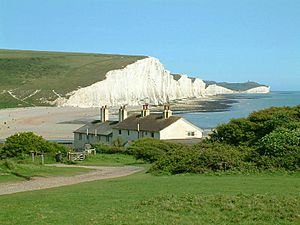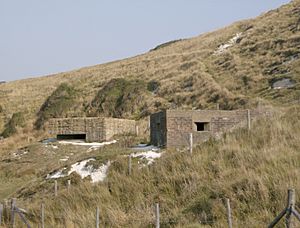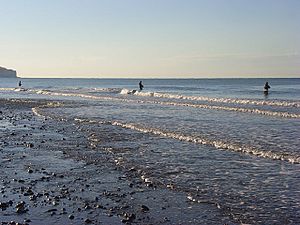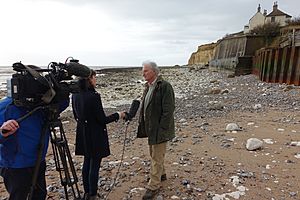Cuckmere Haven facts for kids

Cuckmere Haven is a beautiful area in Sussex, England. It's where the River Cuckmere flows into the English Channel. You can find it between the towns of Eastbourne and Seaford. The river here is a great example of a meandering river, which means it has lots of winding bends. You can even see some U-shaped lakes called oxbow lakes, which form when a river's bend gets cut off.
Cuckmere Haven is a very popular place to visit, with about 350,000 people coming each year. Visitors enjoy long walks and fun water activities on the river. The beach at Cuckmere Haven sits right next to the famous chalk cliffs known as the Seven Sisters.
If you visit at low tide, you might spot the remains of the Polynesia. This was a German sailing ship that got stuck here in April 1890. It was carrying a cargo of sodium nitrate, which is a type of salt.
Contents
History of Cuckmere Haven

For hundreds of years, from the 1500s to the 1700s, the beach at Cuckmere Haven was a popular spot for smuggling. Smugglers would secretly bring goods into the country to avoid paying taxes. For example, in 1783, two large groups of smugglers, each with 200 or 300 people, managed to overpower law officers and carry away many illegal goods.
During the Second World War, German planes from the Luftwaffe (the German air force) flew over Cuckmere Haven. They were looking for places where they could land troops if they invaded the UK. Because of this, the British built many defenses to stop any invasion. You can still see some of these today, like pillboxes (small concrete bunkers), anti-tank obstacles, ditches, and traps designed to stop tanks. The river was also filled with mines to prevent enemy boats from entering. At night, lights were placed to trick German bombers into thinking they were over Newhaven, a nearby port town. An airfield was also set up further inland.
A company called the East Sussex Transport and Trading Company used to dig up gravel from the beach. They had a small railway, only about 1.6 kilometers (1 mile) long, to carry the gravel to the road at Exceat. This railway operated from the early 1930s until 1964. Today, the footpath on the east side of the river follows the old railway line.
Villages and Cottages in the Park
Two small villages, Exceat and Foxhole, are located within the park area. There's also a small group of cottages right on the cliff edge. These are known as the coastguard cottages and are mostly used as holiday homes today.
Exceat is near the Friston Forest car park. It has some old farm buildings, a cafe, and even a tiny old shepherd's caravan. The name Exceat comes from an old English word meaning "exit," because it was a place where people would leave to sail out to the Channel.
Foxhole is another group of farm buildings with a large pond in the middle. The Seven Sisters Country Park rangers live in two of the houses there. One of the barns has been turned into a place where people can camp, and there's also a field for tents. This spot, called Foxhole Campsite, used to be very helpful for people walking the South Downs Way long-distance path.
The Coastguard Cottages
The famous coastguard cottages at Cuckmere Haven were built soon after the National Coastguard Service was started in 1822. Before this, Cuckmere Haven was a very important place for smugglers. The coastguards were there to stop them.
However, the cliffs in front of the cottages have been worn away by the sea. This process, called coastal erosion, has caused the cliff face to move back by more than 30 meters (about 100 feet)! Also, storms have washed away the shingle from the beach below the cottages. All of this puts these historic buildings in danger. Because of this, people have started a fundraising campaign to help protect these well-known cottages.
Wildlife and Nature

Cuckmere Haven is home to many different kinds of wildlife and has a very rich natural environment. Sheep and cattle graze in the fields, which helps keep the grass at a good level. Birds like woodpigeons and rooks look for food in the fields, while water birds like oystercatchers search for food in the wet meadows. This creates a fertile area with many different places for animals to live. The beaches are made of shingle (small, smooth stones), and when the tide is low, you can find rock pools along the shoreline.
Since 2019, the entire coastline of the South Downs National Park, including Cuckmere Haven, has been named a Marine Conservation Zone. This means it's a special area protected for its important marine wildlife.
Fish
- The short-snouted seahorse
Reptiles
Mammals
- Badgers
- Rabbits live in the sandy banks near the main path.
- Red foxes
- You'll also see domestic cattle (mostly young bullocks) and sheep grazing all around the park. These animals are mainly owned by Foxhole Farm. Visitors are asked to keep their dogs under close control at all times.
Birds
- Black-headed gull
- Brent goose
- Canada goose
- Carrion crow
- Common sandpiper
- Northern fulmars build nests on the cliffs in summer.
- Green woodpecker
- Grey heron
- Grey wagtail
- Greylag goose
- Herring gull
- Jackdaw
- Kestrel
- Little egrets often nest in the marshy area by the beach.
- Little grebe
- Meadow pipit
- Oystercatcher
- Pied wagtail
- Common pochard
- Common redshank
- Reed bunting
- Ringed plover
- Rook
- Raven
- Sand martins build burrows in the sand banks to nest in summer.
- Shelduck
- Short-eared owl
- Skylarks sing high above the hills to the east of the river.
- Stonechat
- Swallow
- Wigeon
- Woodpigeon
Images for kids




